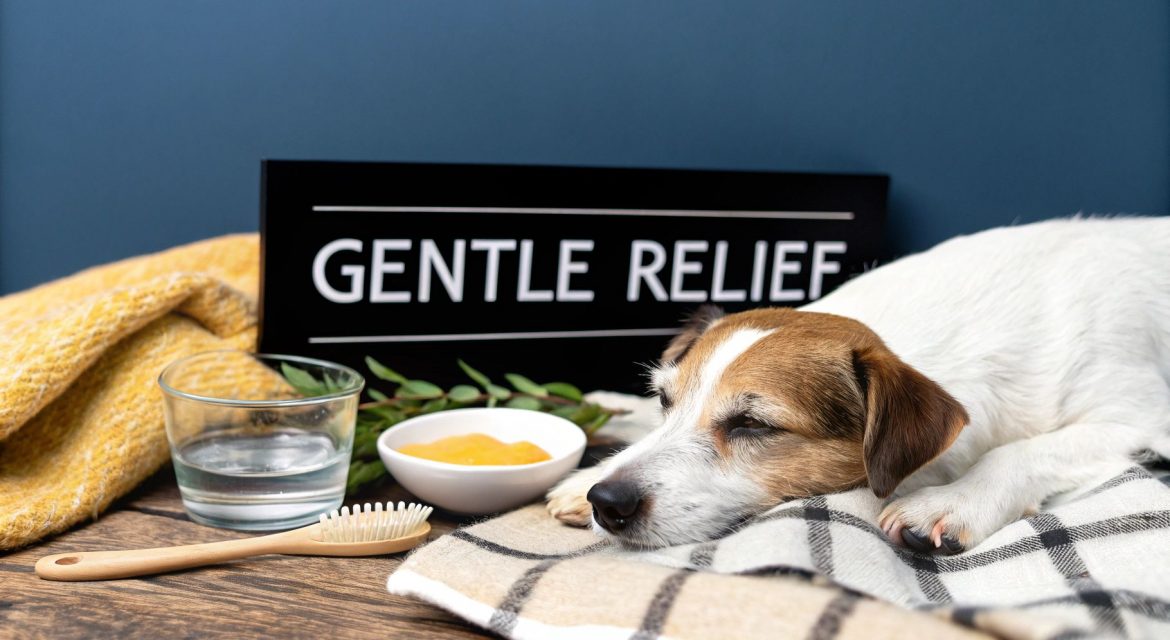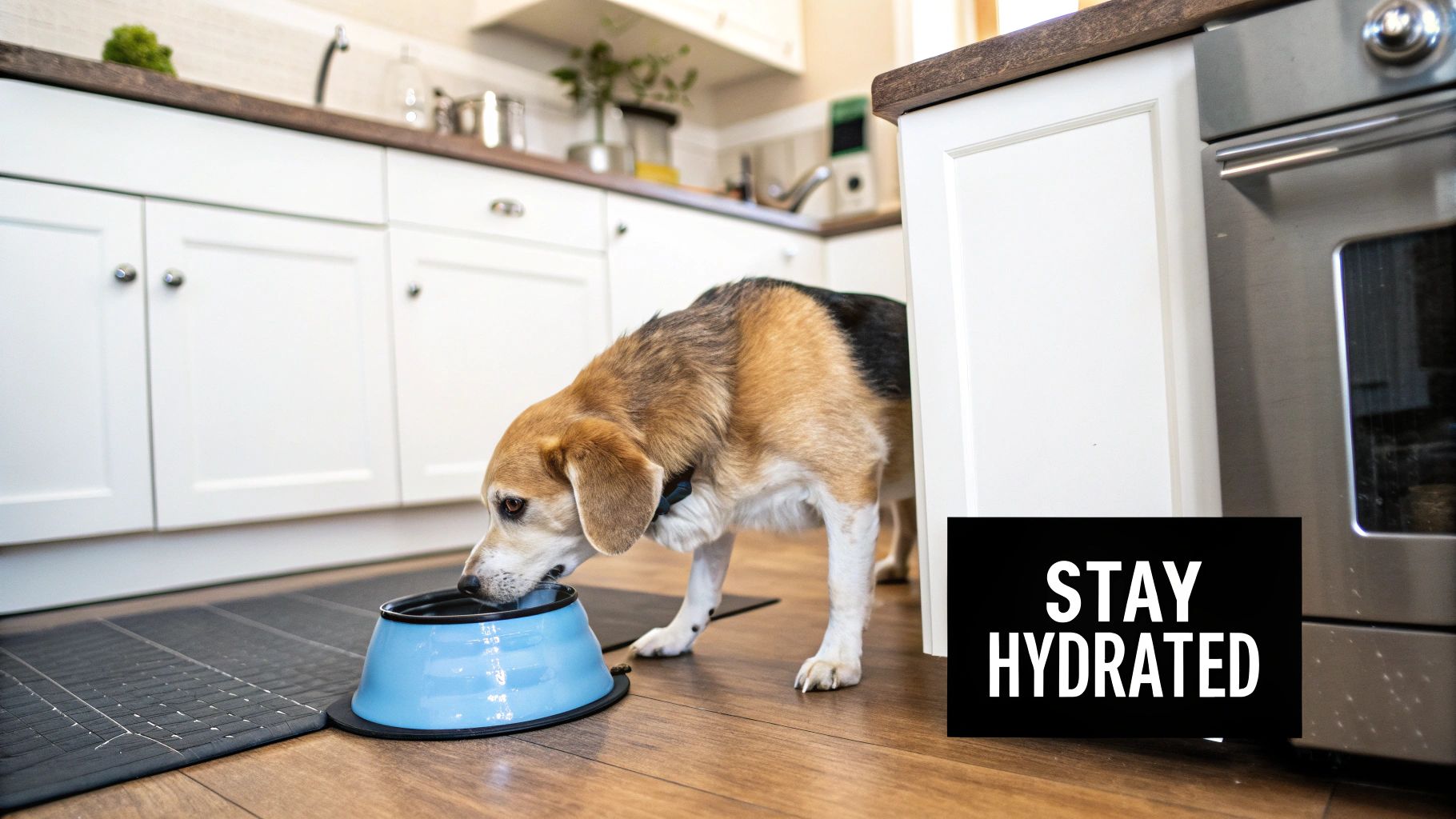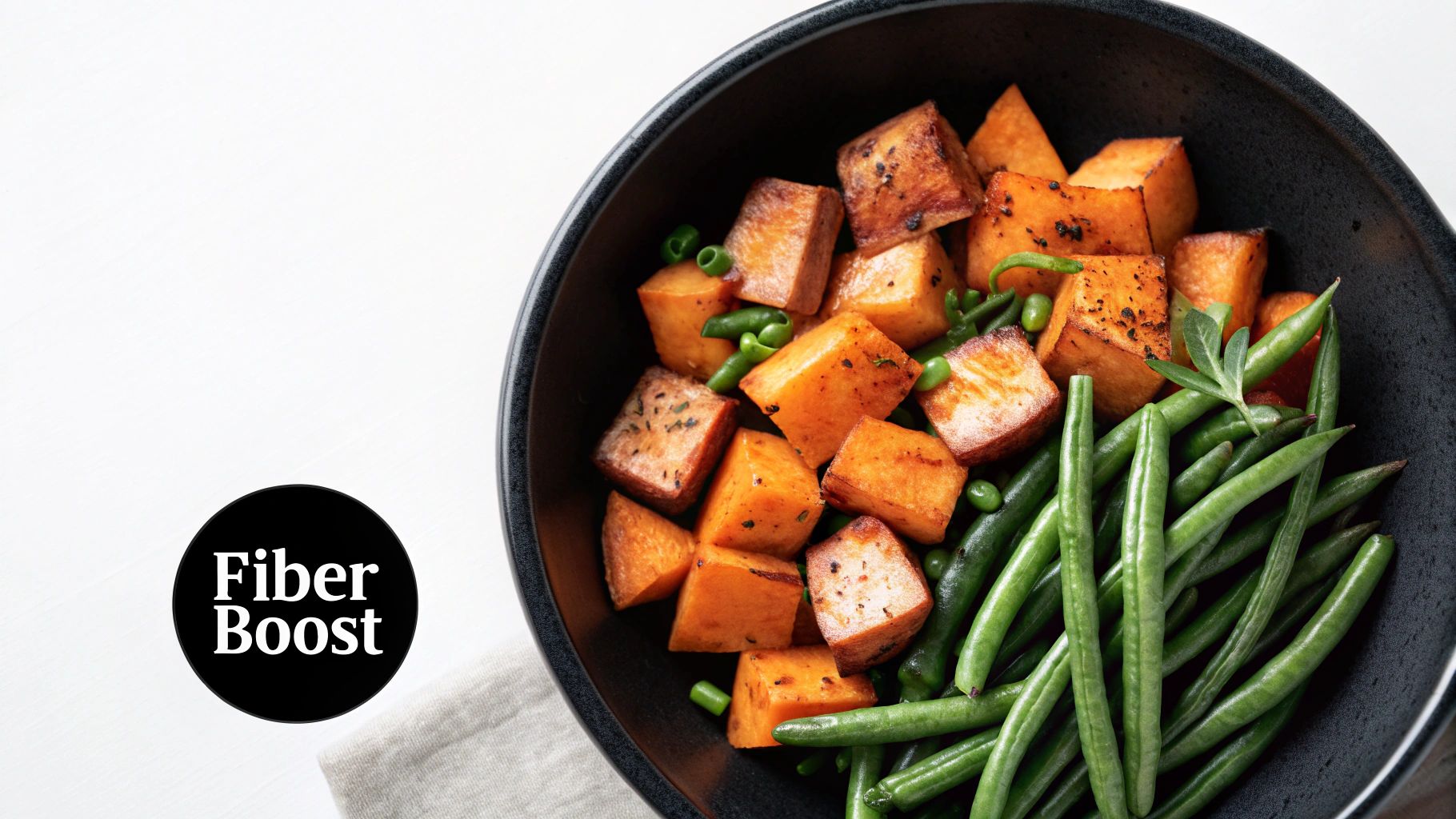It's just awful seeing our furry friends uncomfortable, isn't it? When your dog is struggling to 'go', it's completely natural for you to feel worried. That look of strain, the clear discomfort, and the unsuccessful attempts can be distressing for both of you. We truly understand that feeling of helplessness and the deep desire to provide immediate relief.
The good news is that you're in exactly the right place. Before you rush to the vet, there are several gentle and effective ways we can help from the comfort of your own home. Mild cases of constipation can often be managed with simple, loving adjustments to their diet and daily routine.
This guide is designed to walk you through some of the most reliable dog constipation home remedies. Together, we'll explore why they work, how to use them safely, and what signs tell us it's time to seek professional veterinary advice.
Together, we'll get that tail wagging freely again. We'll approach this with all the care and empathy in the world, ensuring your best friend gets the gentle support they need. Remember, you know your dog best, and taking these proactive steps shows what a wonderful and caring pet parent you are. Let's get started on this journey to comfort and relief.
1. Increased Water Intake and Hydration
One of the simplest yet most powerful dog constipation home remedies is to focus on your pet’s hydration. Just like with us, dehydration is a primary culprit behind difficult or infrequent bowel movements. When your dog doesn't drink enough water, their colon absorbs excess moisture from the stool to maintain bodily functions. This results in hard, dry faeces that are really difficult to pass.
Ensuring your furry friend is well-hydrated helps keep their digestive system running smoothly. Adequate water intake softens the stool, making it easier for them to go to the toilet without all that straining. It’s a foundational step that supports all other bodily processes and is often the first thing a vet will ask you to check.
Why It's A Top Remedy
This approach is so crucial because it addresses the root cause of many constipation cases. It’s a non-invasive, completely natural solution that promotes their overall health, not just digestive regularity. Before we try other remedies, making sure your dog is properly hydrated can often solve the problem entirely. It's also vital to recognise the symptoms of dehydration early. You can learn more about the signs of dehydration in dogs to stay ahead of potential issues.
How to Encourage Your Dog to Drink More
Some dogs can be a bit picky with their water, but we can use a few simple tricks to increase their water consumption and help relieve their constipation.
- Make Water More Appealing: Try adding a splash of low-sodium chicken or beef broth to their water bowl. The enticing smell and flavour can encourage even the most reluctant dogs to drink up.
- Switch to Wet Food: If you normally feed your dog dry kibble, consider switching to or mixing in some wet food. Wet food has a much higher moisture content, which contributes significantly to their daily hydration needs.
- Use a Pet Water Fountain: The sound and movement of a water fountain can be more attractive to some dogs than a static bowl, encouraging them to drink more frequently throughout the day.
- Keep It Fresh and Accessible: Make sure fresh, clean water is always available. We suggest placing multiple bowls in different areas of your home so your dog never has to go far for a drink.
2. Pumpkin Puree Supplementation
A classic and widely recommended solution, pure pumpkin puree is one of the most effective dog constipation home remedies you can have in your pantry. It works wonders thanks to its powerful combination of fibre and moisture. Pumpkin contains both soluble and insoluble fibre, which helps bulk up stool and absorb excess water, promoting smooth and regular bowel movements.
The high water content in pumpkin puree also adds crucial moisture to your dog’s digestive tract. This combination helps soften hard, dry stools, making them much easier for your furry friend to pass without straining. It's a gentle, natural approach that veterinarians and pet nutritionists frequently endorse for digestive support.
Why It's A Top Remedy
Pumpkin is a top-tier remedy because it’s both safe and incredibly effective for mild constipation. It’s an easily accessible, affordable, and palatable option that most dogs enjoy. Unlike some remedies that can be harsh, pumpkin works gently to get your dog’s system back on track, supporting their overall gut health without causing digestive upset when used correctly.
How to Safely Add Pumpkin to Your Dog's Diet
Incorporating pumpkin is simple, but it's crucial we do it correctly to help relieve your dog's constipation. Always ensure you are using 100% pure pumpkin puree, not pumpkin pie filling, as the latter contains sugar, spices, and other ingredients that can be harmful to our dogs.
- Correct Dosage: Let's start with a small amount and mix it into their regular food.
- Small dogs (under 15 lbs): 1/4 to 1/2 teaspoon daily.
- Medium dogs (15-35 lbs): 1/2 to 1 teaspoon daily.
- Large dogs (over 35 lbs): 1 to 2 teaspoons daily.
- Easy Portioning: A great tip is to freeze leftover puree in an ice cube tray for convenient, pre-portioned servings.
- Encourage Picky Eaters: If your dog is hesitant, try mixing the puree with a small amount of warm water to create a more appealing gravy-like consistency.
- Proper Storage: An opened can of pumpkin puree can be stored in an airtight container in the refrigerator for up to one week.
3. Increased Physical Exercise and Movement
One of the most natural dog constipation home remedies is simply getting your best friend moving. Regular physical activity is fantastic for their overall health and plays a direct role in stimulating the digestive system. Movement encourages the muscles in your dog’s intestines to contract, a process called peristalsis, which helps push stool through the colon more efficiently.
A sedentary lifestyle can lead to a sluggish digestive tract, causing waste to move too slowly and become dry and hard. By incorporating more exercise into your dog's daily routine, you can help kick-start their natural bowel functions and provide gentle, effective relief from constipation without invasive measures. It's a simple change that makes a huge difference.
Why It's A Top Remedy
This remedy is highly effective because it works in perfect harmony with your dog’s natural physiology. Exercise doesn’t just burn energy; it massages the internal organs and improves blood flow to the digestive system, promoting regularity. It addresses a common underlying cause of constipation, especially in our older or less active dogs, and offers a host of other health benefits, including weight management and a happier mood.
How to Get Your Dog Moving
Getting your dog more active doesn't have to be complicated. Our goal is consistent, gentle movement to stimulate their gut. Here are some simple ways we can increase their physical activity:
- Go for Regular Walks: Let's aim for two 15-30 minute walks each day. The steady rhythm of walking is excellent for encouraging bowel movements.
- Play a Game of Fetch: A quick 10-15 minute session of fetch in the garden can get their heart rate up and their digestive system moving.
- Try Low-Impact Activities: For dogs with joint issues, swimming is a fantastic, gentle exercise that works their whole body.
- Incorporate Indoor Play: On rainy days, let's not skip the activity. You can find plenty of engaging indoor games for dogs to keep them active and mentally stimulated.
- Take Them Out Post-Exercise: Be sure to give your dog a potty break immediately after a walk or play session, as this is often when they will feel the urge to go.
4. Dietary Fiber Addition (Sweet Potato and Green Vegetables)
Boosting your dog's fibre intake with natural, whole foods is one of the most effective dog constipation home remedies you can try. Dietary fibre, both soluble and insoluble, works wonders for their digestive system. Insoluble fibre adds bulk to the stool, helping it move through the intestines, while soluble fibre absorbs water, making the stool softer and easier to pass.
Adding dog-safe vegetables like sweet potato or green beans provides this necessary fibre along with essential vitamins and nutrients. This natural approach helps regulate bowel movements without resorting to harsh laxatives, supporting your dog’s gut health in a gentle and nourishing way. It's a simple change to their diet that can make a world of difference.
Why It's A Top Remedy
This method is a standout because it addresses digestive sluggishness by enhancing your dog's existing diet with natural, beneficial ingredients. It’s a proactive and wholesome way to not only relieve current constipation but also to promote long-term digestive regularity. Unlike some commercial supplements, using fresh vegetables ensures you know exactly what your dog is consuming, free from any additives or fillers.
How to Add Fibre to Your Dog’s Diet
Introducing high-fibre vegetables is straightforward, but it’s important we do it correctly to avoid upsetting your dog's stomach. Always cook vegetables and never add any salt, oil, or seasonings.
- Offer Cooked Sweet Potato: Mash one to two tablespoons of cooked sweet potato and mix it into your dog's regular food. It's naturally sweet and palatable for most dogs.
- Use Steamed Green Beans: Chopped, steamed green beans make a great low-calorie food topper or treat. A few beans are usually enough to provide a nice fibre boost.
- Incorporate Carrots or Broccoli: Add one or two tablespoons of diced, cooked carrots or small, steamed broccoli florets. Make sure they are cut into small, manageable pieces to prevent choking.
- Introduce New Foods Slowly: When adding any new food, let's start with a small amount and gradually increase it over three to five days. This gives your dog’s digestive system time to adjust.
5. Gentle Abdominal Massage
A gentle abdominal massage can be a surprisingly effective and deeply comforting dog constipation home remedy. This hands-on approach helps to manually stimulate the intestines, encouraging the natural wave-like muscle contractions (peristalsis) that move stool through the digestive tract. It can also help to relieve discomfort from trapped gas and bloating, providing your dog with much-needed comfort.
This technique is a wonderful way for you to bond with your pet while actively helping their digestive system get back on track. For a dog feeling uncomfortable and bloated, your soothing touch can be incredibly reassuring, turning a simple remedy into a loving, calming experience. It directly addresses the physical stagnation in the gut, helping to get things moving from the outside in.
Why It's A Top Remedy
This method is highly recommended because it is non-invasive, drug-free, and directly encourages the body’s own natural processes. When your dog is constipated, their intestinal muscles may be sluggish. A gentle massage acts as an external prompt, helping to break up and move impacted faecal matter along the colon. It is an immediate, comforting action you can take to provide relief.
How to Perform a Gentle Abdominal Massage
To ensure the massage is both safe and effective, it’s crucial to be gentle and attentive to your dog’s reactions. Our goal is to relax and stimulate, not to cause any pain.
- Find a Relaxed Setting: Choose a time when your dog is calm and comfortable, perhaps lying on their side.
- Use Your Palm: With a flat palm, start on your dog’s right side and make slow, gentle, clockwise circular motions on their belly. The clockwise direction follows the natural path of the colon.
- Apply Light Pressure: The pressure should be very light, similar to what you would use to rub your own eye. Begin near the rib cage and slowly work your way down toward their hind legs.
- Keep Sessions Short: Let's aim for 5-10 minute sessions, two to three times a day.
- Watch for Discomfort: Pay close attention to your dog’s body language. If they tense up, yelp, or show any signs of pain, stop immediately.
- Follow Up with a Walk: After the massage, a short, gentle walk can further encourage a bowel movement.
6. Small Amount of Olive Oil
Introducing a small, controlled amount of olive oil into your dog’s diet can be an effective dog constipation home remedy. This kitchen staple acts as a natural lubricant for the digestive tract, helping to soften hard stool and make it easier for your dog to pass. The healthy monounsaturated fats in olive oil can also stimulate the digestive system, encouraging bowel movements.
This remedy works by gently coating the inside of the intestines and the stool itself, reducing friction and easing its passage. It’s a mild approach that can be particularly helpful for occasional, mild bouts of constipation where your dog just needs a little extra help to get things moving again.
Why It's A Top Remedy
Olive oil is a great choice because it’s a readily available, natural, and gentle lubricant. Unlike some harsher laxatives, it works with the body's digestive processes without causing significant disruption. For mild constipation, it can provide relief quickly and easily, making it a go-to solution for many pet parents like us who want to try a simple, at-home approach first.
How to Use Olive Oil Safely
Using olive oil correctly is key to ensuring it helps without causing unwanted side effects like an upset stomach or diarrhoea. Let's always use high-quality, extra virgin olive oil and stick to the proper dosage based on your dog's size.
- Small Dogs (under 9 kg / 20 lbs): 1/4 teaspoon per day.
- Medium Dogs (9-27 kg / 20-60 lbs): 1/2 teaspoon per day.
- Large Dogs (over 27 kg / 60 lbs): 1 teaspoon per day.
Mix the oil directly into their food once daily. It’s important to see this as a temporary fix, not a daily supplement. If you want to explore the topic further, you can find out more about if dogs can have olive oil for general health. We recommend starting with a smaller amount to see how your dog tolerates it and monitoring them closely. If constipation persists or you notice any adverse reactions, stop using it and consult your vet.
7. Warm Water Enema (Last Resort)
A warm water enema is a more intensive home remedy that we should only use as a last resort for severe dog constipation before seeking immediate veterinary care. This method involves gently introducing lukewarm water into your dog's rectum to soften impacted stool and stimulate a bowel movement. Due to its invasive nature and potential for injury if performed incorrectly, this is not a first-line treatment and should only be considered if other, gentler remedies have failed.
This procedure works by directly hydrating and breaking up hard, dry faeces that are stuck in the colon, providing lubrication and creating pressure that encourages expulsion. It can offer quick relief for a severely blocked-up dog, but it carries risks. It is crucial to approach this method with extreme caution and, ideally, after consulting with your vet over the phone for guidance.
Why It's A Last Resort Remedy
This approach is reserved for critical situations because of the potential for rectal injury or causing an electrolyte imbalance if done improperly. It is a direct intervention that bypasses the natural digestive process, so it's not a solution for chronic constipation. You should only attempt this if you are an experienced pet owner, confident in handling your dog calmly, and have exhausted safer dog constipation home remedies like dietary changes and exercise.
How to Administer a Warm Water Enema Safely
If you and your vet have decided this is a necessary step, proceeding with care and the right tools is paramount. Never force the procedure if your dog shows signs of distress or pain.
- Prepare Your Supplies: You will need a paediatric-sized bulb syringe, lukewarm (body temperature) water, and petroleum jelly. Never use hot or cold water, as it can cause discomfort or shock.
- Measure the Water Carefully: The amount of water is critical. Use approximately 1-2 ounces for small dogs, 2-4 ounces for medium dogs, and 4-6 ounces for large dogs. A small amount of mineral oil can be added to the water, but please consult your vet first.
- Lubricate and Insert Gently: Apply a generous amount of petroleum jelly to the tip of the syringe. With your dog lying comfortably on its side on some towels, lift their tail and gently insert the syringe tip only 1-2 inches into the rectum.
- Administer and Wait: Slowly and gently squeeze the bulb to introduce the water. Remove the syringe and keep your dog in a safe, easy-to-clean area, as they should feel the urge to defecate almost immediately.
7 Key Dog Constipation Home Remedies Compared
| Remedy | Implementation Complexity 🔄 | Resource Requirements 💡 | Expected Outcomes 📊 | Ideal Use Cases 💡 | Key Advantages ⭐ |
|---|---|---|---|---|---|
| Increased Water Intake and Hydration | Low – simple adjustment | Minimal – water, possibly broth/fountains | Moderate – relief in 12-24 hrs | Mild to moderate constipation; general health | Safe, cost-effective, improves overall health |
| Pumpkin Puree Supplementation | Low – easy to add to food | Low – pumpkin puree only | High – works in 6-12 hrs | Mild constipation; adding fiber and moisture | Fast-acting, nutritious, palatable |
| Increased Physical Exercise and Movement | Moderate – routine commitment | None to low – time and space | High – immediate and long-term | Dogs with mild to moderate constipation, general fitness | Improves digestion and overall health, free |
| Dietary Fiber Addition (Sweet Potato & Green Vegetables) | Moderate – food prep required | Low – common veggies | Moderate to high – gradual effect | Long-term digestive health, weight management | Nutritious, natural, supports gut health |
| Gentle Abdominal Massage | Low to Moderate – learning technique | None | Moderate – immediate soothing | Mild constipation, discomfort relief | Non-invasive, no cost, strengthens bond |
| Small Amount of Olive Oil | Low – easy to mix with food | Minimal – olive oil | High – works in 6-12 hrs | Mild constipation, short-term use only | Quick effect, healthy fats |
| Warm Water Enema (Last Resort) | High – invasive procedure | Minimal equipment but some skill needed | Very high – immediate relief | Severe constipation unresponsive to other remedies | Rapid relief, prevents emergency vet visit |
Your Next Steps: Knowing When to Call the Vet
Navigating your dog’s discomfort can be stressful, but you are now equipped with a powerful toolkit of safe and effective dog constipation home remedies. From the simple yet potent addition of pumpkin puree to their bowl, to the gentle encouragement of more physical activity and proper hydration, you have a range of compassionate options to help get things moving again for your furry friend.
We've explored how a small amount of olive oil can provide lubrication, how fibre-rich vegetables like sweet potatoes can add necessary bulk, and even how a gentle abdominal massage can stimulate their digestive system. These strategies represent our first line of defence, allowing you to provide immediate, gentle relief using items you likely already have in your home. Your proactive and loving approach demonstrates your deep commitment to their comfort and wellbeing.
The Crucial Role of Observation
While these home-based solutions are often successful for mild, infrequent bouts of constipation, your role as a vigilant pet parent is paramount. Mastering these remedies is not just about knowing what to do, but also about understanding their limitations. The true value lies in pairing this knowledge with your careful observation of your dog’s overall condition.
Key Takeaway: Success isn’t just about relieving the constipation; it's about recognising the difference between a minor digestive hiccup and a symptom of a more serious underlying problem. Your attentiveness is your dog's best protection.
When Home Remedies Aren't Enough
It is absolutely crucial to recognise the signs that indicate a problem beyond the scope of home care. Please put these remedies aside and contact your veterinarian immediately if you notice any of the following red flags:
- Prolonged Symptoms: The constipation lasts for more than 48-72 hours.
- Signs of Pain: Your dog is crying out, yelping when you touch their abdomen, or showing visible distress when trying to defecate.
- Vomiting or Lethargy: Your dog is sick, seems unusually tired, or has lost their appetite.
- Blood in Stool: You notice any blood in their stool or straining produces only a small amount of bloody fluid.
- Complete Inability to Defecate: Despite straining, your dog is producing no faeces at all (a condition known as obstipation), which is a medical emergency.
Trust your intuition. You know your dog better than anyone. If something feels off, or if they just don't seem like their usual happy self, a quick phone call to your vet is always the wisest and kindest course of action. It provides peace of mind for you and ensures your beloved companion receives the professional care they may urgently need. Think of your vet as your partner in your dog's health journey; we are here to empower you with knowledge, while they are there to provide essential medical expertise.
At My Life My Dog, we believe that a well-informed owner is the best advocate for their pet's health. For more personalised guidance, expert-led courses on canine nutrition, and a supportive community of fellow dog lovers, explore our resources at My Life My Dog and take the next step in becoming the most confident pet parent you can be.









